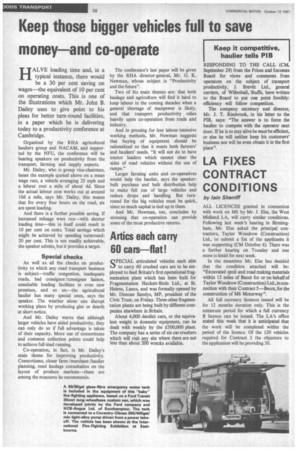Keep those bigger vehicles full to save money and co-operate
Page 40

If you've noticed an error in this article please click here to report it so we can fix it.
HALVE loading time and, in a typical instance, there would be a 30 per cent saving on wages—the equivalent of 10 per cent on operating costs. This is one of the illustrations which Mr. John B. Dailey uses to give point to his pleas for better turn-round facilities, in a paper which he is delivering today to a productivity conference at Cambridge.
Organized by the RHA agricultural hauliers group and NACAM, and supported by the NFU, the conference will he hearing speakers on productivity from the transport, farming and supply aspects.
Mr. Dailey, who is group vice-chairman, bases the example quoted above on a mean wage rate, a vehicle averaging 25 mph and a labour cost a mile of about 4d. Since the actual labour cost works out at around 10d a mile, says Mr. Dailey, this means that for every four hours on the road, six are spent loading.
And there is a further possible saving. If increased mileage were run—with shorter loading time---this in itself could result in 10 per cent on costs. Total savings which might be achieved by speeding turnround: 20 per cent. This is not readily achievable, the speaker admits, but it provides a target.
Special checks
As well as all the checks on productivity to which any road transport business is subject—traffic congestion, inadequate roads, bad consignor /consignee liaison, unsuitable loading facilities in even new premises, and so on—the agricultural haulier has many special ones, says the speaker. The weather alone can disrupt working plans by producing glut or dearth at short notice.
And Mr. Dailey warns that although larger vehicles have aided productivity, they can only do so if full advantage is taken of their capacity. More use of consortiums and common collection points could help to achieve full-load running.
Co-operation, in fact, is Mr. Dailey's main theme for improving productivity. Consortiums, closer farm /merchant /haulier planning, road haulage consultation on the layout of produce markets—these are among the measures he recommends. The conference's last paper will be given by the RHA director-general, Mr. G. K. Newman, whose subject is "Productivity and the future".
Two of his main themes are: that both haulage and agriculture will find it hard to keep labour in the coming decades when a general shortage of manpower is likely, and that transport productivity relies heavily upon co-operation from trade and industry.
And in pressing for less labour-intensive working methods, Mr. Newman suggests that buying of equipment should be rationalized so that it meets both farmers' and hauliers' needs. "It will not do to have tractor loaders which cannot clear the sides of road vehicles without the use of ramps."
Larger farming units and co-operatives would help the haulier, says the speaker: bulk purchase and bulk distribution help to make full use of large vehicles and reduce drops and handling. But turnround for the big vehicles must be quick, since so much capital is tied up in them.
And Mr. Newman, too, concludes by stressing that co-operation can provide some of the most productive returns.


































































































































